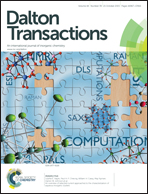Differences in XPS and solid state NMR spectral data and thermo-chemical properties of iso-structural compounds in the series KTaF6, K2TaF7 and K3TaF8 and KNbF6, K2NbF7 and K3NbF8†
Abstract
A series of compounds KTaF6, K2TaF7 and K3TaF8 and KNbF6, K2NbF7 and K3NbF8 was investigated by means of XPS and MAS NMR spectroscopy and DSC measurements. Electron binding energies of all accessible orbitals were discussed and, for the first time, correlations between different orbital energies were examined. 19F MAS NMR data and other NMR parameters of the investigated compounds were correlated with structural information, as well as with XPS data. Also a complete set of DSC data was presented including a number of phase transitions and their heat contents. Based on measured characteristics it was shown how differences in the electronic structure of isostructural compounds influence the spectral and thermo-chemical behaviour of the investigated pairs, i.e. KTaF6vs. KNbF6, K2TaF7vs. K2NbF7 and K3TaF8vs. K3NbF8. It was concluded that the differences in K 2s orbital energies play an important role in the different behaviour of tantalate and niobate analogues.


 Please wait while we load your content...
Please wait while we load your content...